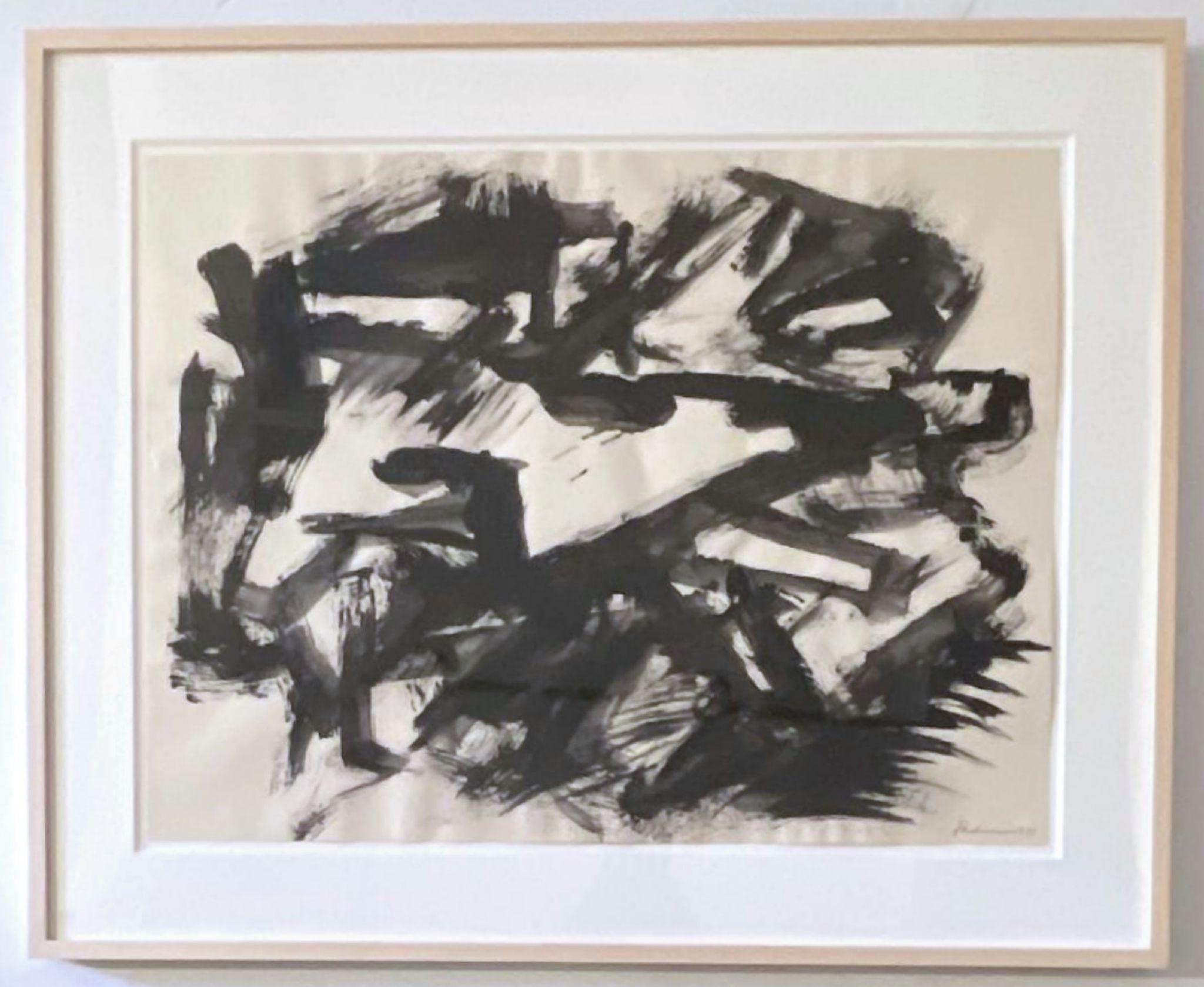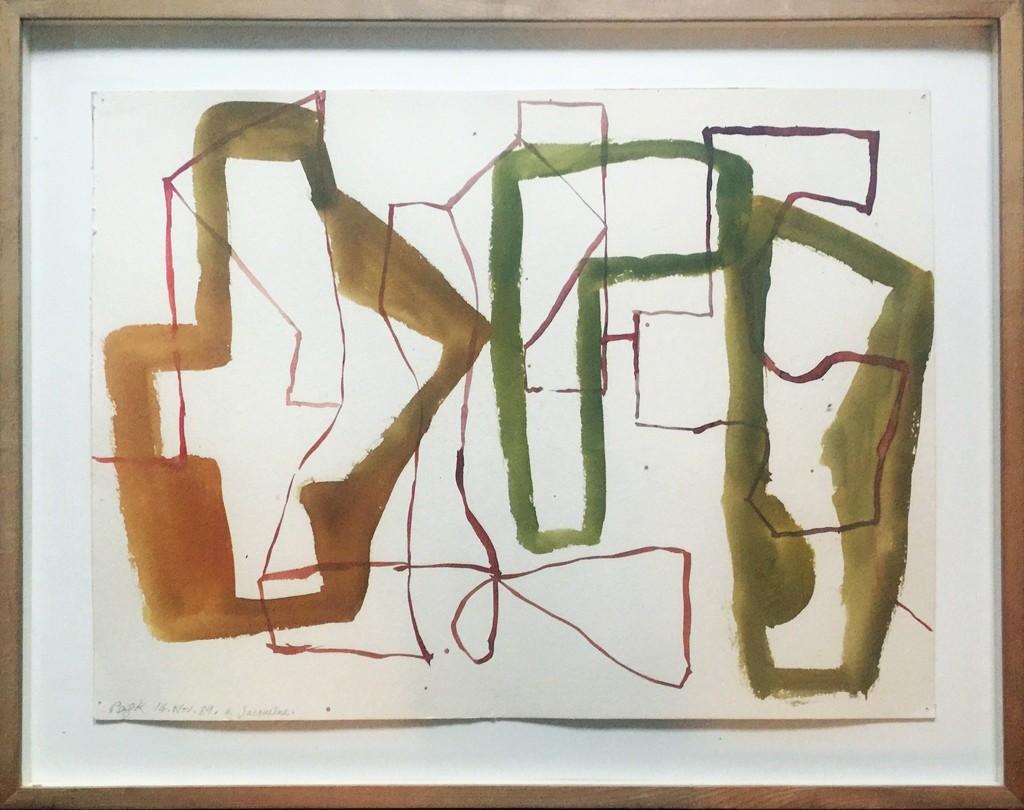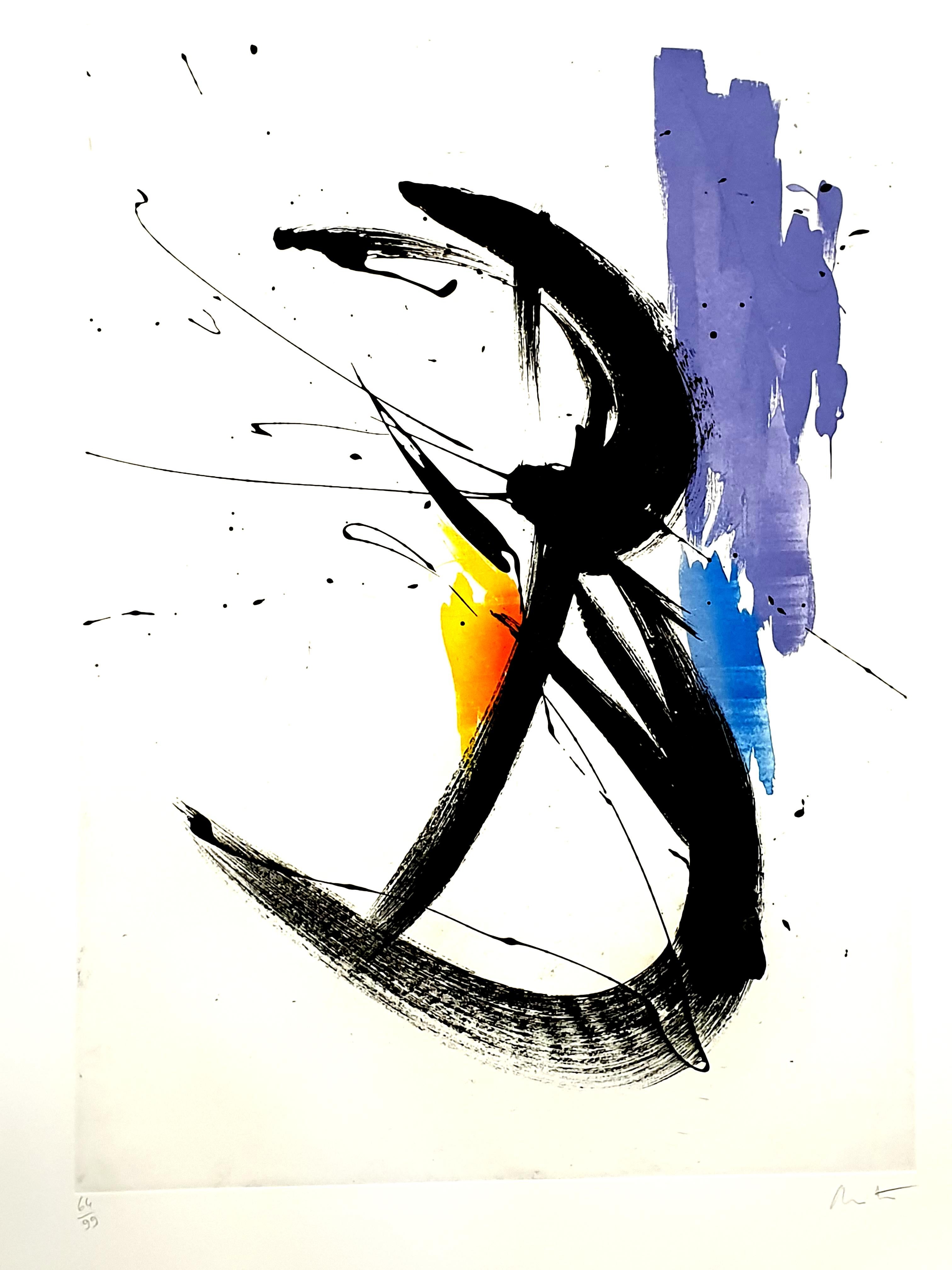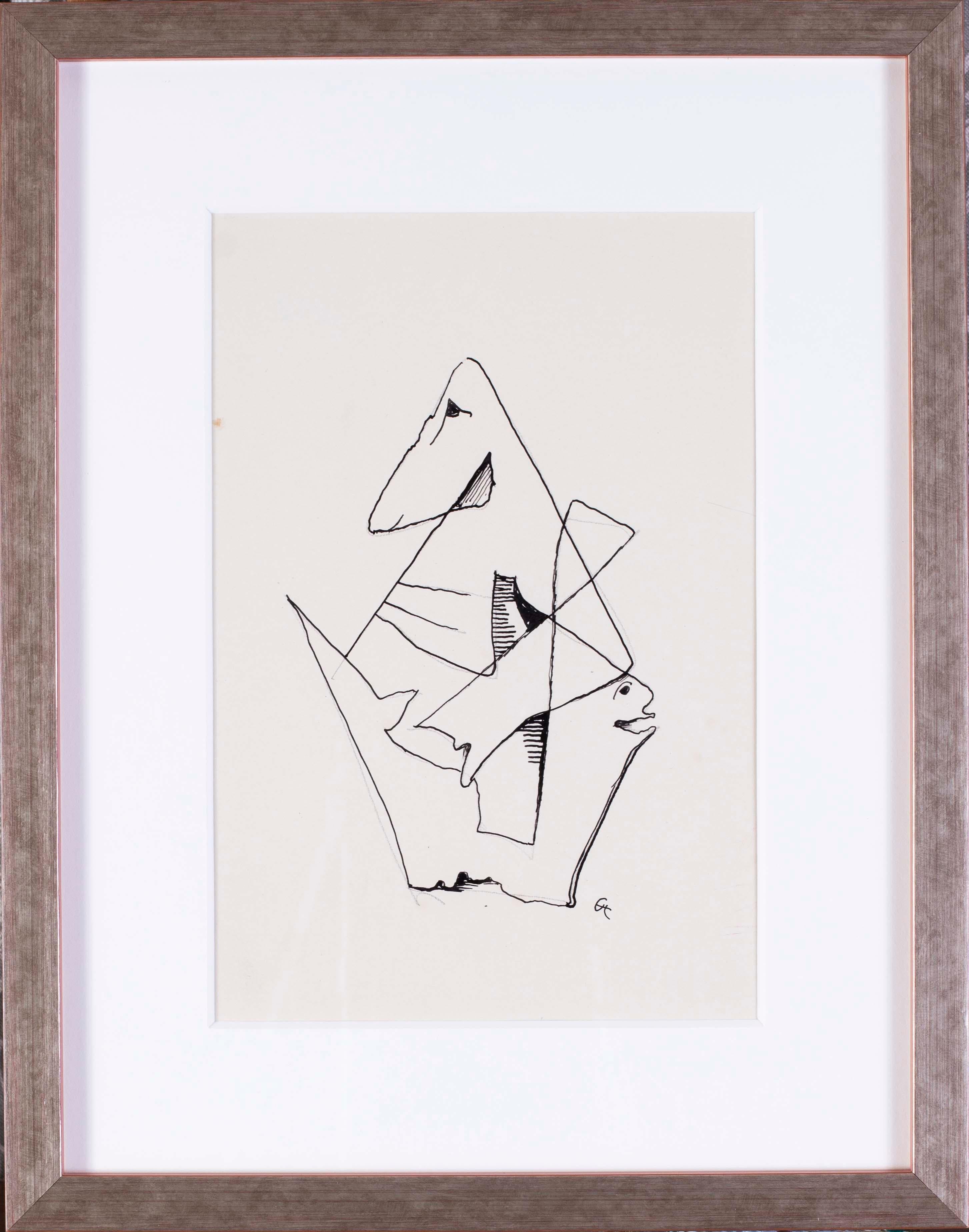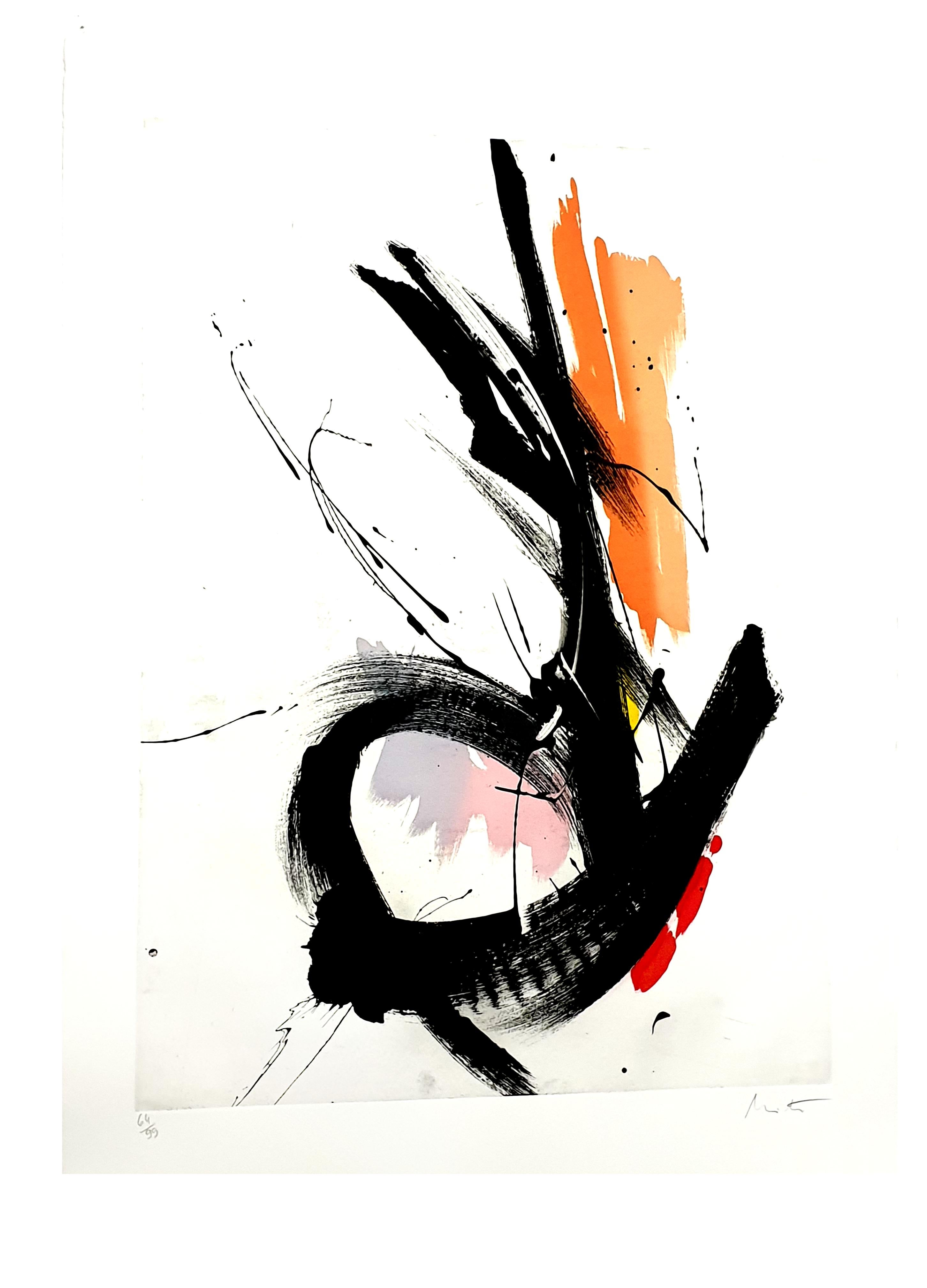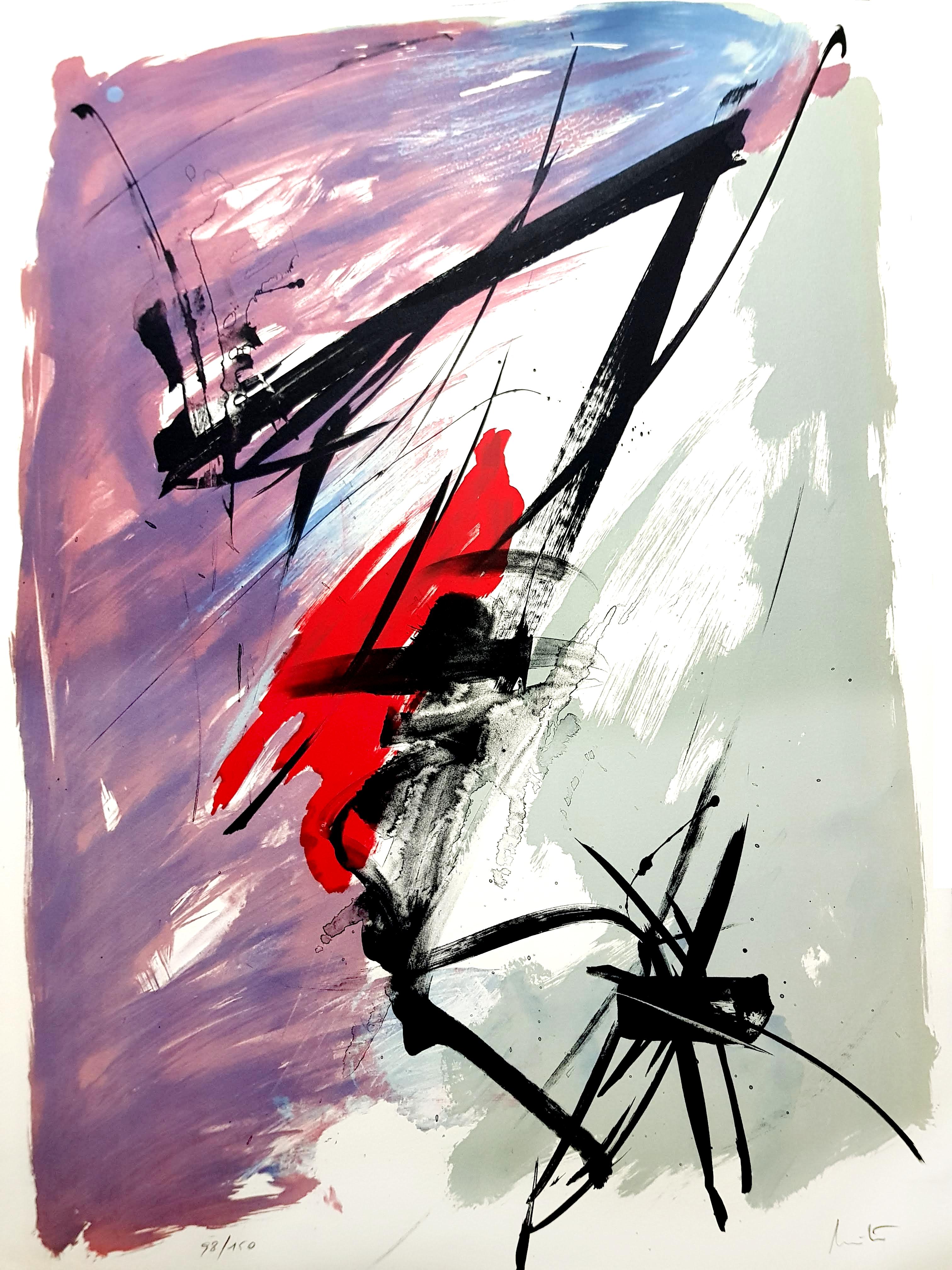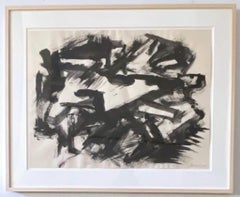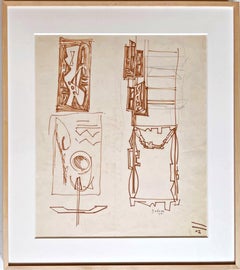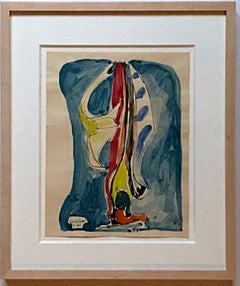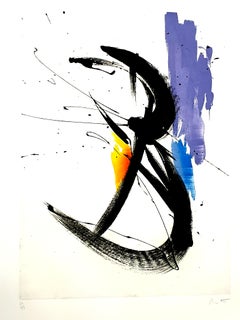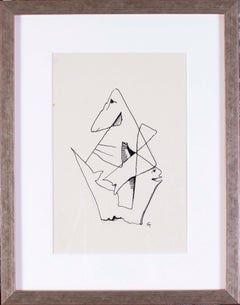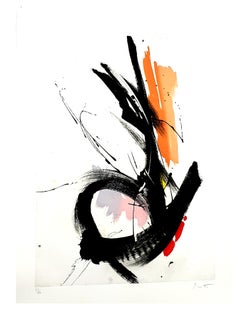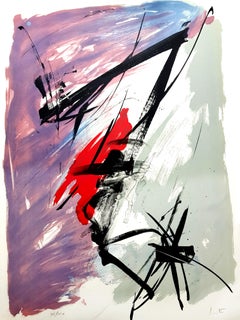Items Similar to Herbert Ferber, Abstract Expressionist sculptural study signed framed Provenance
Want more images or videos?
Request additional images or videos from the seller
1 of 9
Herbert FerberHerbert Ferber, Abstract Expressionist sculptural study signed framed Provenance1968
1968
$2,800
£2,126.25
€2,435.65
CA$3,976.09
A$4,349.24
CHF 2,273.89
MX$52,387.85
NOK 28,420.51
SEK 26,810.76
DKK 18,181.84
About the Item
Herbert Ferber
Untitled, 1968
Unique Ink and color wash on paper
Hand signed and dated by the artist on the front
Framed with original Knoedler Gallery label (under the respected director Larry Rubin)
This excellent untitled sculptural drawing done by the renowned abstract expressionist sculptor and painter, Herbert Ferber. Hand signed and dated by the artist on the front. Framed and ready to hang and in good vintage condition. The work bears the original Knoedler gallery label, from under the prestigious direction of Lawrence Rubin.
Measurements:
Frame:
16 1/4 x 16 1/4 x 1/2 inches
Sheet:
11 x 14 inches
Provenance:
Bears the Knoedler and Company label on the back. From the original Knoedler gallery under Larry Rubin.
Herbert Ferber Biography
(1906-1991)
One of the few Abstract Expressionist artists working in three dimensions, Herbert Ferber explored the concerns of his age in dynamic and visually interesting sculptures over the course of a career that uniquely expresses the collective artistic vocabulary at midcentury. In a body of work that spans several decades, Ferber’s sculptural practice develops slowly and thoughtfully to incorporate elements of Surrealism, social realism, and expressionism.
After some early work with direct wood carving, Ferber moved “beyond the monolith” in the early 1940s in the form of modeled bronze. (1) This allowed the artist to explore more attenuated and expressionist form and opened up his practice to some of the Surrealist influence in which his contemporaries were also interested. This period also saw Ferber’s move into complete abstraction, his thinned forms becoming ever more like drawing in space. Drawing was in fact an important component of Ferber’s process, and several preparatory works on paper preceded each sculptural work. Drawing “enabled Ferber to loosen and open up his shapes and to free himself from a specific, literal image and move toward simplification and fluency” in sculpture. (2)
In the 1950s and 60s Ferber explored the relationship between organic and geometric line, most notably in his series of “cage” sculptures. These large-scale works featured sweeping organic forms contained within strictly rectilinear framing devices. The artist also plays with the boundaries of balance and counterbalance in sculptures both large and small. This untitled work from 1966 embodies both of these directions in Ferber’s work. The organic form of the swirling circle is interrupted by the aggressively geometric jaggedness of Ferber’s lines in space. The entire form also leans dynamically to one side, counterbalanced by the small base on which it stands.
Born in New York City in 1906, Ferber attended the City College of New York from 1923 until 1926, majoring in science while concurrently developing an interest in fine art and the humanities. He went on to study dentistry and oral surgery at Columbia University, where he received his D.D.S. While in medical school, Ferber was required to make anatomical drawings; this is where he first discovered his skill as an artist. While attending dentistry school, he also enrolled at the Beaux Arts Institute of Design from 1927 through 1930. Ferber did, in fact, work as a practicing dentist for several years and also taught dentistry part time at Columbia through the mid 1970s when he fully devoted himself to sculpture.
In the years 1930-1931, Ferber made his first woodcarvings, and by the end of 1932 he had fully come into his own within the medium. His early work was representative – often of the human form – which is likely a direct response to his anatomy drawings as a medical student. His work became increasingly more abstract as the years went on. Following his strict representational period, Ferber developed a growing concern for social causes. He work took a particularly social-realist turn with his interest in the changing social, political, and economic climate of the 1930s. It was at this same time, around 1936, that he joined a John Reed Club and the Artist’s Union. While participating in these organizations he attended talks by influential social-realist Mexican muralists José Clemente Orozco and David Alfaro Siqueiros, who were visiting New York to publicize social-realist art. However, by the late 1930s Ferber had become disillusioned with Stalinist politics and began to break away from John Reed and the Artist’s Union. Social-realist themes remained somewhat present in his work moving forward, but in a less literal manner. His first one-man show was comprised of works in wood and was held in 1937 at Midtown Gallery in New York. Before the end of the 1940s, he had given up wood as a medium, insisting that he had done all that he could with the material.
As for many American artists who spent their formative years on this side of the Atlantic, Ferber’s first trip to Europe was especially influential. In 1938 he visited a covey of churches and cathedrals in both France and Italy and was particularly influenced by Romanesque sculpture, especially that of Moissac, Souillac, and Carcassone. Between the years of 1938 and 1945, his work was heavily affected by what he termed the “false perspective” of Romanesque capitals.
As Ferber’s career progressed, he experimented more and more with different types of metal and different ways to achieve a sound structural form. For Ferber, though, materials were a matter of pragmatics. He often spoke strongly against the fetishization of materials – his greatest critique of the Bauhaus. He believed that ideas were at the heart of art
making, not techniques or materials (3). A notable part of Ferber’s process, a direct product of his influence from Henry Moore, is the drawing phase. Scholar William C. Agee
goes so far as to call Ferber a “compulsive draftsman,” whose studies are full blown wash drawings that are similar to paintings. Agee cites Ferber’s drawing process as a significant strain in his identity as an artist. His interest in drawing combined with his affection for Miró and Picasso indicates that Ferber, Alexander Calder, David Smith, and other artists of that generation no longer wished to draw a distinct delineation between painting and sculpture (4). Ferber, Smith, Calder, and Theodore Roszak all began as painters before shifting into three dimensions, and were thus more inclined to ignore the barriers between the mediums. There is evidence of this approach to sculpture in Ferber’s work such as Metamorphosis I that tends towards a more attenuated line, and openness and a thinness that otherwise looks painted in space.
By 1946, Ferber was belatedly, but deeply immersed in Surrealism. This shift in style and poetics was the result of Ferber’s contact with the artists of the Betty Parsons Gallery, which he joined in the same year. These artists and others from Kootz Gallery that included Jackson Pollock, William Baziotes, Mark Rothko, and others were all exploring the possibilities of Surrealism in their work. Ferber’s new interest in Surrealist ideas such as impulse, the unconscious, and mythologies radically altered his art making. Agee cites Rothko’s Surrealist paintings from 1944-1946 as major influences in Ferber’s own work at the time.
Between 1949 and 1950, Ferber had reasserted his interest in the work of Julio Gonzalez, Picasso’s sculpture mentor and an influential figure in Ferber’s early sculpting years. He became more conscientious of the formal elements of artmaking once again, and slowly moved away from his more radical Surrealist tendencies. This more restrained approach forced a physical shift in aesthetic as well, and his work moved more toward verticality and abstraction. The artist experimented with wall sculpture at this time, but soon he was taken with the possibilities of space. Minimalism, a contemporaneous movement, was equally concerned with the viewer’s engagement with space and how the built form affected this engagement. While Ferber’s work could hardly be described as Minimalist, it was in dialogue with similar phenomenological concepts. The next step in his interest in space was in his integration of a frame and later a “roof and wall” structure as part of the sculpture. This suggestion of an enclosed room was a byproduct of the artist’s interest in creating a room-sized environment (5).
By 1958, Ferber was in close contact with art critic and historian E.C. Goossen. Together, they developed a growing concern for emulating the effect on the viewer caused by large-scale painting in three dimensions. Goossen wrote about the topic in an article titled “The Big Canvas.” The two shared a firm belief in the intimacy one experienced when engaging with a painting, especially on a grand scale. While Ferber claims that he never stopped painting, this year marks an important integration of the medium in his own art making. Work from this point forward shows an increased awareness of somehow injecting a painterly presence into his sculptures. He was still working on thinning the line of demarcation between the two mediums.
Ferber’s work can be found in the collections of the Albright-Knox Art Gallery, Buffalo; the Cantor Arts Center, Stanford University, Palo Alto; the Dallas Museum of Art; the Honolulu Museum of Art; the National Gallery of Art, Washington, D.C.; the Newark Museum; the Pennsylvania Academy of the Fine Arts; the Whitney Museum of American Art, New York; the Jewish Museum, New York; and the Yale University Art Gallery, New Haven, among others. Ferber died in 1991 in North Egremont, Massachusetts
- Creator:Herbert Ferber (1906-1991, American)
- Creation Year:1968
- Dimensions:Height: 16.25 in (41.28 cm)Width: 16.25 in (41.28 cm)Depth: 0.5 in (1.27 cm)
- Medium:
- Movement & Style:
- Period:
- Condition:In good vintage condition. Minor rippling, but otherwise very good condition. In vintage frame; frames are not guaranteed.
- Gallery Location:New York, NY
- Reference Number:1stDibs: LU1745215023482
About the Seller
5.0
Platinum Seller
Premium sellers with a 4.7+ rating and 24-hour response times
Established in 2007
1stDibs seller since 2022
453 sales on 1stDibs
Typical response time: 2 hours
- ShippingRetrieving quote...Shipping from: New York, NY
- Return Policy
Authenticity Guarantee
In the unlikely event there’s an issue with an item’s authenticity, contact us within 1 year for a full refund. DetailsMoney-Back Guarantee
If your item is not as described, is damaged in transit, or does not arrive, contact us within 7 days for a full refund. Details24-Hour Cancellation
You have a 24-hour grace period in which to reconsider your purchase, with no questions asked.Vetted Professional Sellers
Our world-class sellers must adhere to strict standards for service and quality, maintaining the integrity of our listings.Price-Match Guarantee
If you find that a seller listed the same item for a lower price elsewhere, we’ll match it.Trusted Global Delivery
Our best-in-class carrier network provides specialized shipping options worldwide, including custom delivery.More From This Seller
View AllUntitled '71 Abstract Expressionist drawing. Signed by renowned sculptor, Framed
Located in New York, NY
Anthony Padovano
Untitled Abstract Expressionist drawing, 1971
Ink wash on paper drawing
Signed and dated in ink wash
Unique
Original (unique) signed Abstract Expressionist ink wash ...
Category
1970s Abstract Expressionist Abstract Drawings and Watercolors
Materials
Ink
Untitled Geometric Abstraction - unique signed and inscribed work -framed
Located in New York, NY
Paul Pagk
Untitled Geometric Abstraction, 1989
Gouache and watercolor on paper
Signed, dated and inscribed "A Jacqueline".
Frame included
Excellent unique work on paper by contempora...
Category
1980s Abstract Geometric Abstract Drawings and Watercolors
Materials
Watercolor, Gouache, Pencil, Graphite
Dorothy Dehner, Mid Century Modern signed abstract sculptural drawing, Framed
By Dorothy Dehner
Located in New York, NY
Dorothy Dehner
Untitled Mid Century Modern abstract sculptural drawing, 1955
Marker and graphite on paper
Signed and dated by Dorothy Dehner in black felt tip pen on the front
Frame ...
Category
1950s Abstract Expressionist Abstract Drawings and Watercolors
Materials
Mixed Media, Permanent Marker, Graphite
Ron Gorchov Mid Century Modern Abstract Expressionist painting on paper Signed
By Ron Gorchov
Located in New York, NY
Ron Gorchov
Untitled early 1960s Abstract Expressionist work, 1962
Ink and watercolor painting on paper
Signed and dated in black ink lower left recto
Frame included:
elegantly floa...
Category
1960s Abstract Expressionist Abstract Drawings and Watercolors
Materials
Ink, Watercolor
Unique signed abstract painting on paper renowned artist, Albright Knox Gallery
By Jene Highstein
Located in New York, NY
Jene Highstein
Untitled, 1982
Pastel and Chalk on Paper
Hand signed and dated by artist on the front
32 × 40 inches
Frame included
Original hand signed pastel and chalk drawing, with...
Category
1980s Abstract Abstract Drawings and Watercolors
Materials
Paper, Chalk, Pastel, Mixed Media
Kimber Smith, Abstract Expressionist Geometric Abstraction signed/n lithograph
By Kimber Smith
Located in New York, NY
KIMBER SMITH
Untitled Abstract Expressionist Geometric Abstraction, 1967
Lithograph on Rives paper
25 × 19 3/5 inches
Signed in silver...
Category
1960s Abstract Geometric Abstract Prints
Materials
Lithograph
You May Also Like
Jean Miotte - Abstract Composition - Original Signed Lithograph
By Jean Miotte
Located in Collonge Bellerive, Geneve, CH
Jean Miotte - Rare Original Signed Lithograph
Title: Abstract Composition
Dimensions: 76 x 56 cm
Edition: 64/99
Signed and Numbered in pencil
Jean Miotte, 1926 - 2016
Miotte came o...
Category
1990s Abstract Expressionist Abstract Prints
Materials
Aquatint
German Expressionist drawing of an abstracted form by Carl Hofer
By Carl Hofer
Located in Petworth, West Sussex
Carl Hofer (German, 1875 – 1955)
Abstracted form
Pencil and pen and ink on paper
Signed with monogram ‘CH’ (lower right)
11.3/8 x 7.1/2 in. (28.8 x 19 cm.)
Provenance: These works c...
Category
Early 20th Century Expressionist Abstract Drawings and Watercolors
Materials
Paper, Ink, Pen, Pencil
Jean Miotte - Abstract Composition - Original Signed Lithograph
By Jean Miotte
Located in Collonge Bellerive, Geneve, CH
Jean Miotte - Rare Original Signed Lithograph
Title: Abstract Composition
Dimensions: 76 x 56 cm
Edition: 64/99
Signed and Numbered in pencil
Category
1990s Abstract Expressionist Abstract Prints
Materials
Aquatint
Jean Miotte - Abstract Composition - Original Signed Lithograph
By Jean Miotte
Located in Collonge Bellerive, Geneve, CH
Jean Miotte - Rare Original Signed Lithograph
Title: Abstract Composition
Dimensions: 76 x 56 cm
Edition: 98/150
Signed and Numbered in pencil
Jean Miotte, 1926 - 2016
Miotte came ...
Category
1970s Abstract Expressionist Abstract Prints
Materials
Aquatint
Abstract Wall Art Drawing/Painting #08312022, Mixed Media on Watercolor Paper
By Michael Verlangieri
Located in Yardley, PA
Hand painted/drawing one of a kind original on 100% cotton Archival watercolor paper With Gold Leaf :: Mixed Media :: Abstract Expressionism :: This piece comes with an official cer...
Category
21st Century and Contemporary Abstract Expressionist Mixed Media
Materials
Mixed Media
Untitled (original framed watercolor on paper)
By Rolph Scarlett
Located in Aventura, FL
Original watercolor on paper. Hand signed and dated lower right by Rolph Scarlett. Artwork size 7.5 x 9.5 inches. Frame size 17.5 x 21.5 inches.
Artwork is in excellent conditio...
Category
1940s Abstract Abstract Paintings
Materials
Paper, Watercolor
$2,100 Sale Price
25% Off
More Ways To Browse
Gallery Provenance
Abstract Expressionist Ink
Vintage Painting Of European Cities
Social Realism Social Realism Art 1930s And 1940s
Romanesque Sculpture
David Smith Artist
Amos Ferguson
Andy Warhol Holy Cats
Ary Stillman
Bob Lazar
Camino Brent
Carl E Schwartz
Cesar Martinez
David Ferreira
E Brodsky
Foire De Paris 1939
Gerardo Chavez
Guy Benoist
